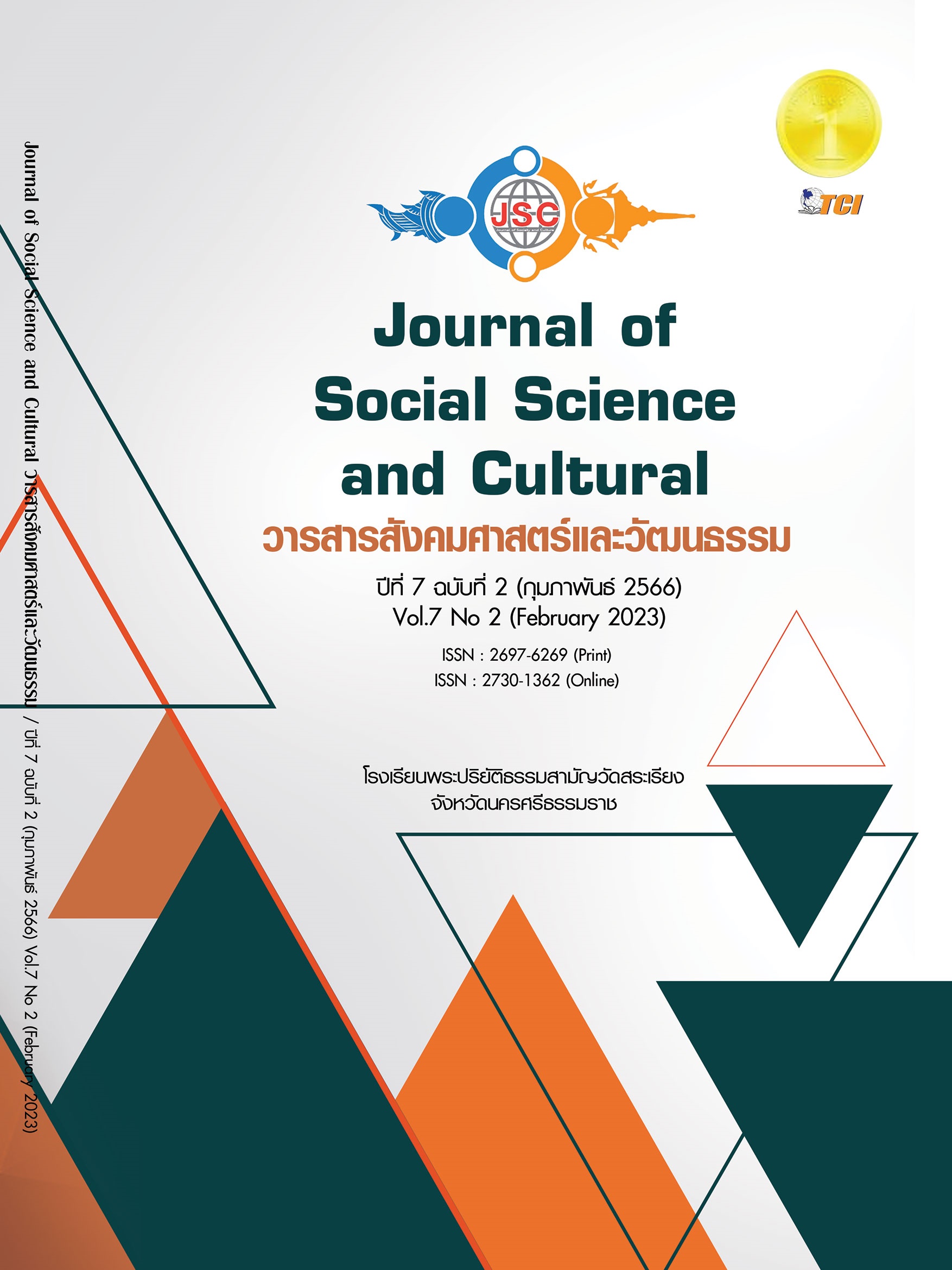DEVELOPMENT OF TOURIST SIGNBOARDS FOR TOURISTS AT THUNG SONG JUNCTION MARKET IN NAKHON SI THAMMARAT PROVINCE
Main Article Content
Abstract
Having frequented Thung Song Junction Market, the researchers noticed that the majority of the signboards for tourists in the market were written in Thai and in poor condition. As a result, the researchers believed it would be appropriate to develop tourist signboards in Thai, English and Chinese in order to benefit the community. The research team conducted this research with the aims of 1) recognizing the preferences and opinions of tourists, shop owners, and Thung Song Junction Market committees in charge of the trilingual signboards; 2) developing the trilingual signboards to help tourists understand how they should behave as well as provide further useful information; and 3) gauging the satisfaction level of tourists, shop owners, and Thung Song Junction Market committees toward the trilingual signboards for tourists. The research instruments consisted of a questionnaire and an interview form. The questionnaire was made up of evaluation forms asking tourists, shop operators and Thung Song Junction Market committees’ preferences and satisfactions for the tourist signboards. The convenience sampling method was used to gather information from 104 participants including 50 tourists, 50 shop operators, and 4 Thung Song Junction Market committees, and six of these informants took part in the interview. The study findings revealed that the overall preferences for the trilingual signboards were found at the highest levels. According to the case-by-case analysis, the tourists visiting Thung Song Junction Market preferred trilingual signboards with proper size that could be easily spotted. Results of the interview revealed that installing tourist signboards also help tourists understand and gain information about the various spots within Thung Song Junction Market.
Article Details
References
กอไผ่ ริมภู. (2563). หลาดชุมทางทุ่งสง ความสำเร็จจากคุณค่าสู่มูลค่า. เรียกใช้เมื่อ 4 พฤษภาคม 2565 จาก https://www.77kaoded.com/news/korphai/1603734
การท่องเที่ยวเชิงวัฒนธรรม. (2556). แหล่งท่องเที่ยวเชิงวัฒนธรรม. เรียกใช้เมื่อ 26 กุมภาพันธ์ 2565 จาก www.tourismdan1.blogspot.com
จักรพงษ์ แผ่นทอง. (2562). การหาค่าความเชื่อมั่นของแบบสอบถาม. เรียกใช้เมื่อ 20 สิงหาคม 2565 จาก https://www.krujakkrapong.com/หาความเชื่อมั่นของแบบสอบถาม
ชวนพ ชีวรัศมี. (2557). การออกแบบระบบป้ายสัญลักษณ์เพื่อใช้ในการสื่อสารระหว่างเจ้าหน้าที่ตำรวจทางหลวงกับชาวต่างชาติโดยอาศัยทฤษฎีการเชื่อมโยงมโนภาพ. วารสารวิชาการ Veridian E-Journal, 7(3), 1374-1387.
นวพล พัฒนชีวกุล และนิติ นิมะลา. (2558). การออกแบบป้ายบอกทิศทางภายในมหาวิทยาลัยราชภัฏอุดรธานี ศูนย์สามพร้าว. วารสารสวนสุนันทาวิชาการและวิจัย Suan Sunandha Acodemic & Research Review, 10(1), 30-41.
ปวีณ์กร คลังข้อง. (2556). วัฒนธรรมวิจัยของครูในจังหวัดปัตตานี. ใน วิทยานิพนธ์ศึกษาศาสตรมหาบัณฑิต สาขาวิชาการบริหารการศึกษา. มหาวิทยาลัยสงขลานครินทร์ วิทยาเขตปัตตานี.
ผู้จัดการออนไลน์. (2562). “หลาดชุมทางทุ่งสง” เดินเพลินชมสินค้าพื้นถิ่น ชิมช้อปของอร่อยพื้นบ้าน. เรียกใช้เมื่อ 25 ตุลาคม 2565 จาก https://www.mgronline.com/travel /detail/9620000102622
พุทธชาด ลิ้มศิริเรืองไร. (2556). ศึกษาและพัฒนาป้ายและแผ่นพับประชาสัมพันธ์ภาษาอังกฤษเพื่อการท่องเที่ยวที่ปราสาทพนมรุ้งและปราสาทต่ำ จังหวัดบุรีรัมย์. ใน รายงานการวิจัย. มหาวิทยาลัยราชภัฏบุรีรัมย์.
ระบบตลาดและเครื่องมือทางการตลาด. (2565). หลาดชุมทางทุ่งสง. เรียกใช้เมื่อ 20 พฤษภาคม 2565 จาก https://mwsc.dit.go.th/viewFreshMarket.php?id= 54942&page=1#.Yz5CG9BByUk
รูฮายาตี อารง และคณะ. (2561). การวิเคราะห์เทคนิคและข้อผิดพลาดจากการแปลภาษาไทยเป็นภาษาอังกฤษ: กรณีป้ายกรมทางหลวงและป้ายสถานที่สำคัญต่าง ๆ ในเขตอำเภอเมืองนราธิวาส จังหวัดนราธิวาส. วารสารมนุษศาสตร์ มหาวิทยาลัยนเรศวร, 19(1), 100-113.
วันวิสา สุขประเสริฐ. (2548). ปัญหาและความต้องการใช้ป้ายสัญลักษณ์และป้ายสื่อความหมายของนักท่องเที่ยวในอุทยานแห่งชาติเขาใหญ่. ใน วิทยานิพนธ์ศึกษาศาสตรมหาบัณฑิต สาขาเทคโนโลยีการศึกษา. มหาวิทยาลัยเกษตรศาสตร์.
วิมลฑา ศิริระเวทย์กุล. (2556). ออกแบบระบบป้ายสัญลักษณ์ภายในหอสมุดแห่งชาติ. ใน รายงานการวิจัย. มหาวิทยาลัยราชภัฏสวนสุนันทา.
Dechawong, S. & Komaratat, S. (2014). The need for Foreign Languages of Temples in Bangkok. In Research report. Dhurakij Pundit University.
Industrialnews. (2020). Tourism industry: Thailand Profitable Business. Retrieved December 19, 2020, from http://industrialnews.com/tourismindustry
Liyun, S. (2016). Development of Basic Chinese Language Learning Activities Package Using Collaborative Learning Model for Secondary 2 Students at Piboonbumpen Demonstration School Burapha University. In Master of Education Thesis. Burapha University.
Nakplad, R. et al. (2021). Needs Analysis and Development of English-Language Tourist Guide Signs at That Noi Temple in Nakhon Si Thammarat Province. Journal of Liberal Arts Prince of Songkla University, 13(2), 170-194.
Newmark, P. (1988). Textbook of Translation. London United Kingdom: Pearson Education Limited.
Thongtong, T. (2016). A Linguistic landscape Study of Signage on Nimmanhemin Road, a Lanna Chiang Mai chill-out Street. MANUSYA: Journal of Humanities, 18(22), 72-87.
Yamane, T. (1973). Statistics: An Introductory Analysis. (3rd Ed). Columbia University, United States: Harper and Row Publications.


